There are many beautiful flowers name starting with D. Dahlia is a popular flower that comes in a range of colors like pink, red, yellow, purple, and white. Daisies are also a favorite among many and come in many varieties such as Shasta daisies and Gerbera daisies.
Daffodils are a classic spring flower that adds a pop of yellow to any garden or bouquet. Delphiniums are tall and stately flowers that come in shades of blue, purple, pink, and white. Another beautiful flower that starts with D is the Dogwood, known for its beautiful pink and white blossoms that appear in the spring.
Lastly, the Dendrobium orchid is a stunning flower that comes in many shades of pink, purple, and white and is often used in wedding bouquets. There are many other flowers that start with the letter D, each with its own unique beauty and charm.
Flowers Name Starting with D
Dahlberg Daisy
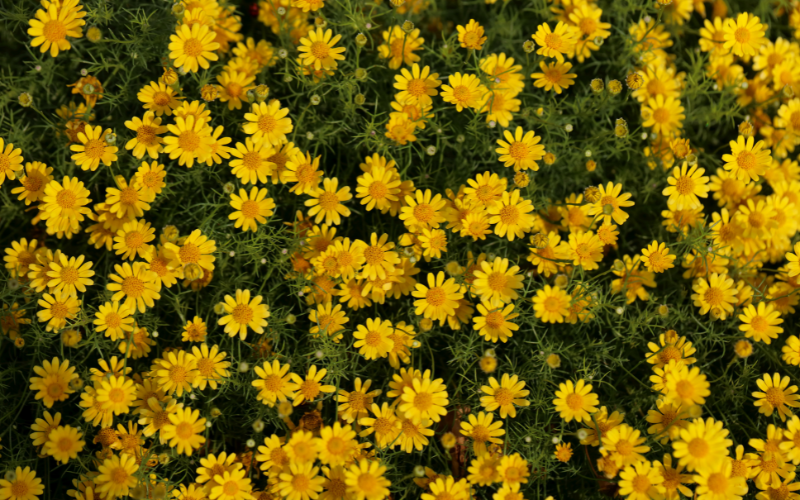
Dahlberg Daisy is a beautiful and delicate flowering plant. It is also known as Golden Fleece. This plant is native to Mexico. The Dahlberg Daisy is a low-growing plant with brilliant green foliage and little yellow blooms that bloom all summer.
This plant is simple to grow and a low-maintenance plant that takes minimal care. This plant is sure to be a beautiful addition to any garden and is a popular choice among gardeners.
| Scientific Name | Thymophylla tenuiloba |
| Native Range | Southwestern United States and Northern Mexico |
| Flowering Season | Spring and early summer |
Dalmatian Bellflower
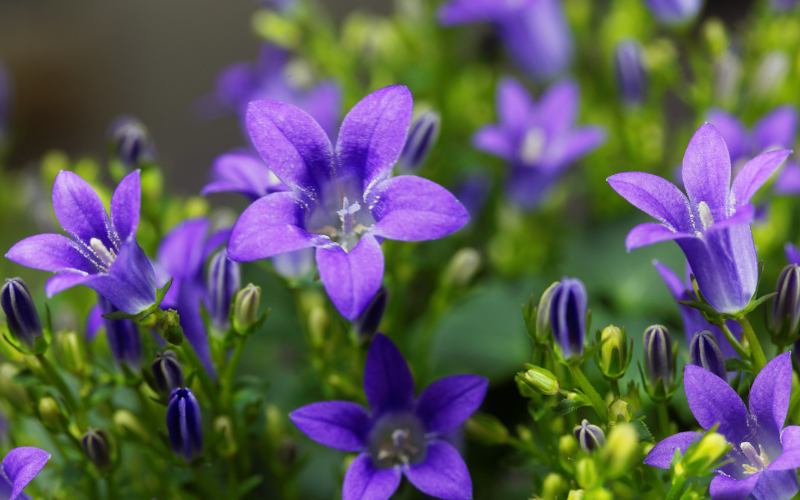
The Dalmatian Bellflower is a stunning plant. It is native to the Balkans and the Carpathian Mountains. It is also known as Campanula Dalmatica. Its bell-shaped flowers are a beautiful violet-blue color and measure around 2 inches in length. The plant itself can grow up to 3 feet tall and 2 feet wide.
It prefers full sun to light shade, as well as moist, well-drained soil. The Dalmatian Bellflower is pretty simple to grow. It’s ideal for attracting butterflies and bees to your yard. It is an excellent choice for gardeners looking for a plant that will produce color in their garden for an extended period of time.
| Scientific Name | Campanula portenschlagiana |
| Native Range | Dalmatian region of Croatia, which is located along the eastern coast of the Adriatic Sea |
| Flowering Season | Late spring and summer months |
Dandelion
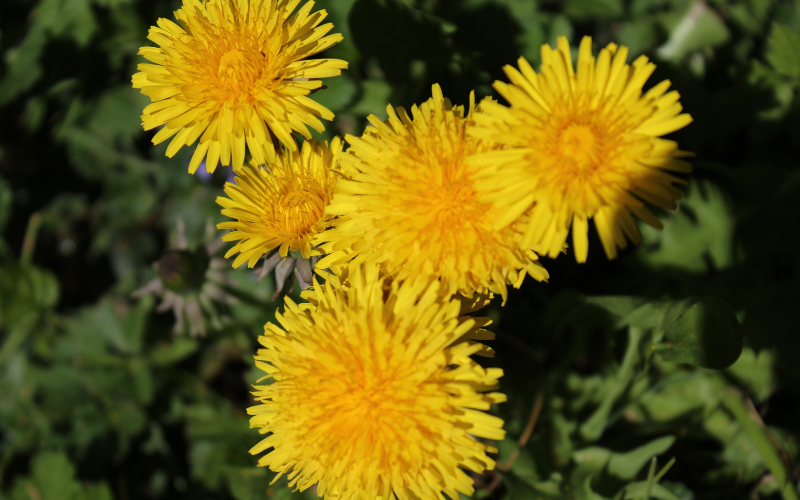
A dandelion is a beautiful flower. Dandelion, scientifically known as Taraxacum officinale. Dandelions typically bloom in the spring and early summer months. Dandelion flowers are also attractive to pollinators, such as bees, butterflies, and other insects, serving as an important food source.
Dandelions are known for their ability to spread quickly and produce numerous seeds. Their bright yellow flowers and fluffy seed heads also make them recognizable and iconic plants in many regions.
| Scientific Name | Taraxacum officinale |
| Native Range | Europe and Asia |
| Flowering Season | All year with an abundance in spring and summer |
Daphne
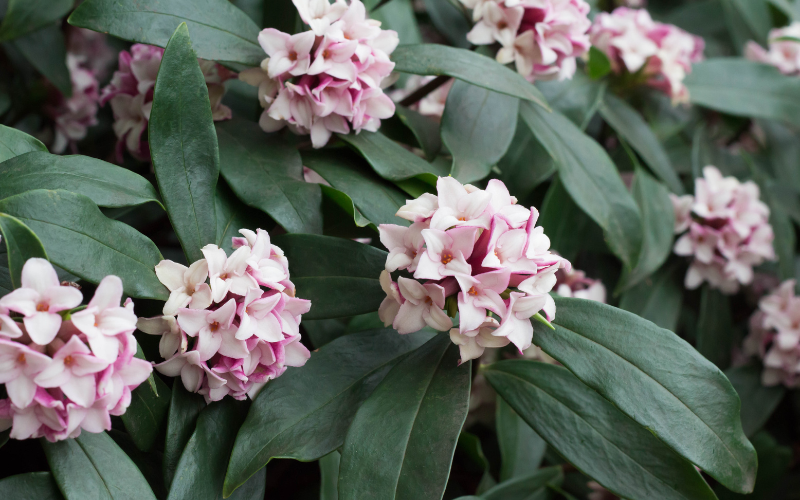
The Daphne flower is a beautiful and lovely plant. The Daphne plant has lovely and distinct blooms that range in color from pink to white, purple to scarlet. The attractive aroma of the Daphne plant makes it a popular choice for gardens.
The plant blooms in late winter or early spring and is an excellent way to bring color and perfume While the Daphne plant is very easy to care for, good soil drainage is required to prevent root rot. This plant can also be difficult to grow in hot, dry conditions.
| Scientific Name | Daphne |
| Native Range | East Asia, including China, Japan, Korea, Europe |
| Flowering Season | During the spring or early summer |
Daylily
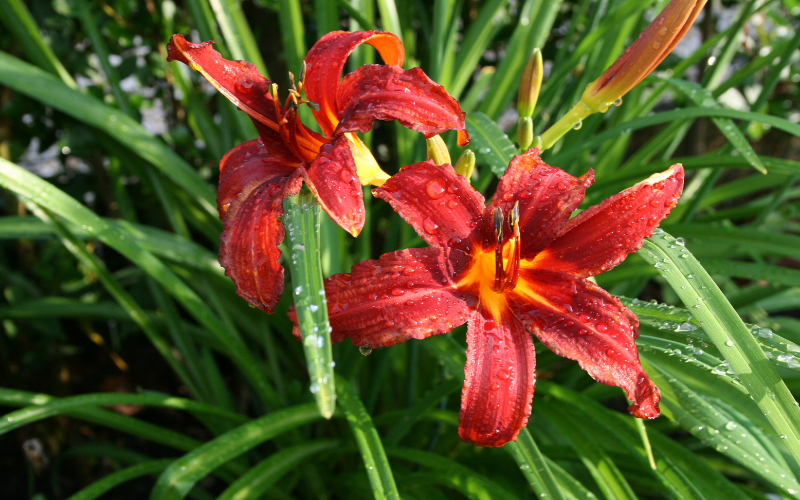
The daylily flower is a beautiful, graceful flower. That is native to Asia. Its botanical name is Hemerocallis, which means “beauty for a day”. The daylily represents beauty, grace, and loyalty.
The daylily bloom is available in a wide range of colors, including pink, orange, yellow, red, and purple. They are particularly well-liked for their ease of maintenance and ability to thrive in a variety of growing environments.
| Scientific Name | Hemerocallis spp. |
| Native Range | Asia and the coasts of the Adriatic Sea |
| Flowering Season | Mid-spring through early summer |
Delphinium
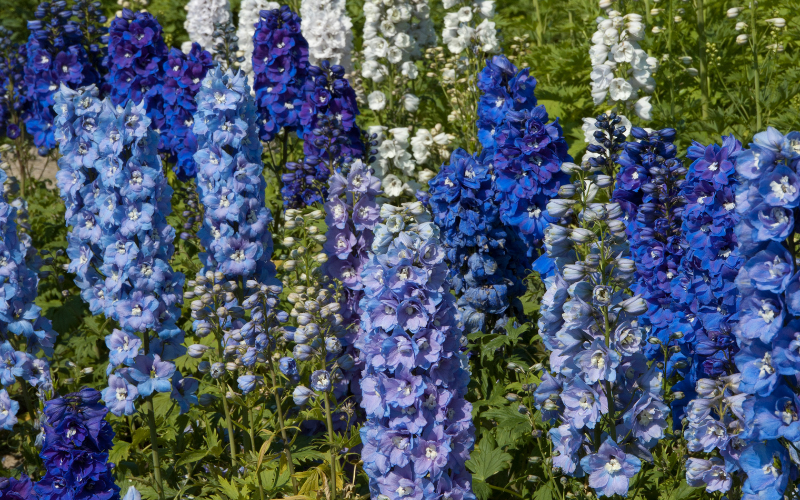
The delphinium flower is one of the most beautiful and gorgeous flowers you can grow in your yard. It is a tall and slender bloom with a variety of colors such as blue, pink, purple, and white.
They have flower spikes that can grow up to six feet tall, making them ideal for the back of a border. Delphiniums thrive in full sunlight and well-drained soil. The delphinium flower has a long history and is frequently associated with symbolism such as love, joy, and light.
| Scientific Name | Delphinium spp |
| Native Range | Throughout the Northern Hemisphere and the high-altitude regions of tropical Africa |
| Flowering Season | Spring to midsummer |
Desert Candle
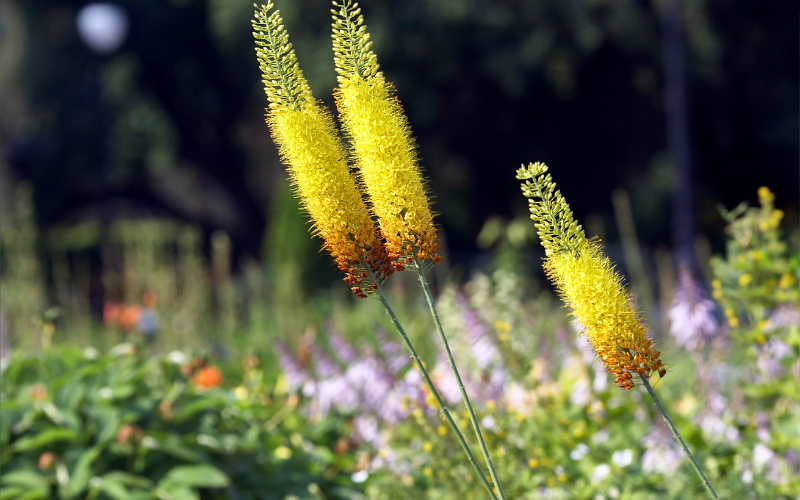
The desert candle is a beautiful flower. That is native to the southwestern United States and Mexico. The desert candle, also known as the ocotillo. Its bark is brown and rough, with sharp spines along the length of it.
What defines the desert candle is its ability to produce beautiful red blossoms at the end of the stem. These flowers only bloom during the warm and humid months of the year, making them uncommon for the majority of the year.
| Scientific Name | Eremurus robustu |
| Native Range | Central Asia, specifically Afghanistan, Iran, and the Himalayan regions of Pakistan and India |
| Flowering Season | Late spring to early summer |
Desert Rose

Desert Rose is a beautiful flower. That is native to the dry regions of Africa and the Middle East. Despite its name, the Desert Rose is a member of the Adenium genus rather than a rose.
The plant can be identified by its thick, fleshy leaves that form a rosette pattern and its tall, slender stem that can reach a height of two feet. The Desert Rose blossoms are equally stunning, with enormous, trumpet-shaped blooms in a variety of colors including pink, red, and white.
| Scientific Name | Adenium obesum |
| Native Range | Arabian Peninsula, southern Sahara, and tropical and subtropical South and Eastern Africa |
| Flowering Season | Early spring through midsummer and autumn |
Devil-in-a-Bush
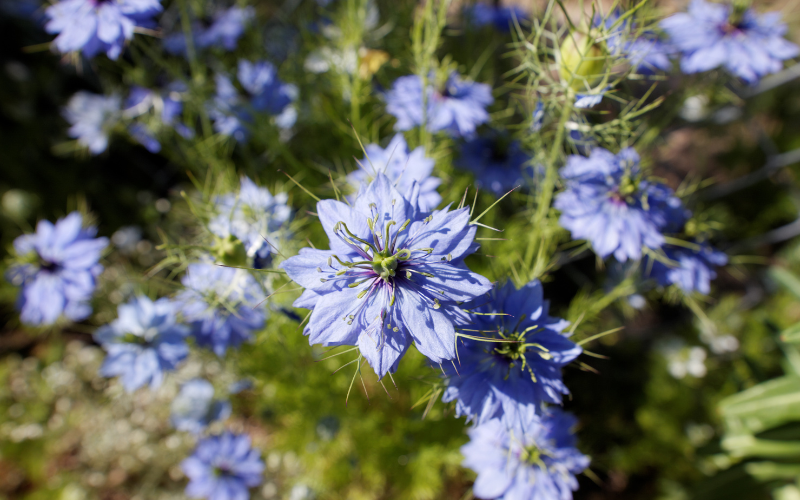
Devil-in-a-Bush is a unique and beautiful plant. That is native to Europe and Asia but is now found worldwide. It belongs to the Buttercup family and has beautiful blue or white flowers set by a spiky collar of green foliage.
The plant is commonly grown in gardens as a decorative plant and attracts a variety of bees and butterflies. It is a fascinating and beautiful plant that adds a touch of elegance and mystery to any garden.
| Scientific Name | Nigella damascena |
| Native Range | The southern regions of Europe, including countries such as Spain, Italy, Greece, and Turkey |
| Flowering Season | Late spring to early summer |
Dew Flower
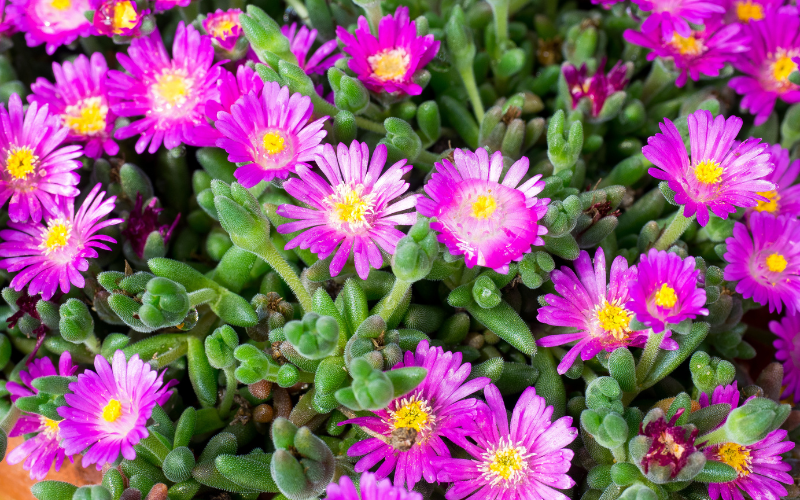
Dew Flower is a beautiful and unique succulent plant. That is native to South Africa. It is known for its unique ability to collect and hold dew droplets on its petals, making it a stunning sight to see early in the morning.
In some cultures, the dew flower is believed to be a symbol of purity and innocence, and it is often used in traditional medicine for its healing properties. The dew flower is a beautiful reminder of the wonders of nature and the importance of appreciating the small things in life.
| Scientific Name | Drosanthemum floribundum |
| Native Range | Southwestern region of South Africa |
| Flowering Season | Spring and summer months |
Dwarf Snapdragon
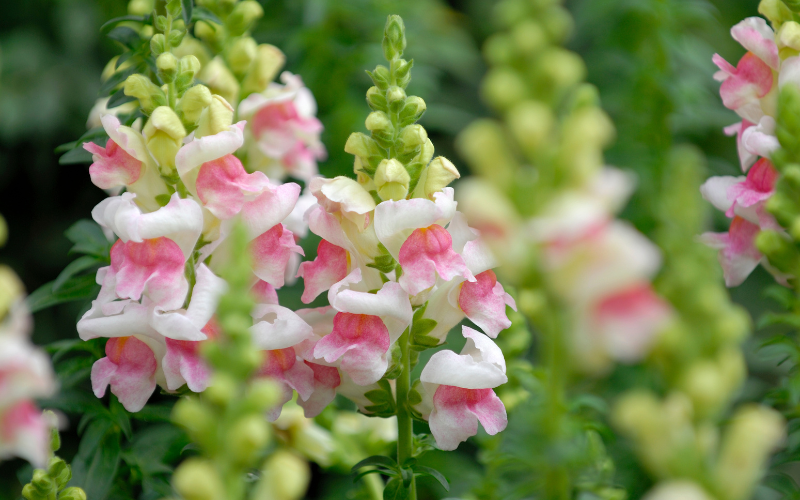
Dwarf Snapdragon is a beautiful flower. Dwarf Snapdragon flowers come in a wide range of colors, including shades of pink, red, orange, yellow, white, and sometimes even bi-colored or multi-colored varieties.
With its compact size, reaching only about 6-8 inches in height. The dwarf snapdragon is known for its unique shape, resembling a dragon’s face. Dwarf Snapdragon flowers are known for their charming appearance and vivid colors.
| Scientific Name | Antirrhinum majus nanum |
| Native Range | France and the Iberian Peninsula |
| Flowering Season | Summer to fall |
Dwarf Nasturtium
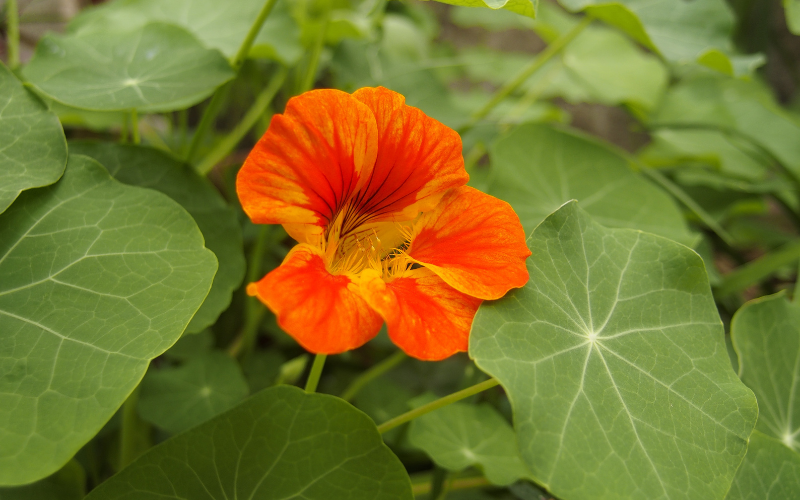
The Dwarf Nasturtium is a beautiful and vibrant flower. The flowers come in a variety of shades, including fiery oranges, sunny yellows, and deep reds, making them a visually stunning addition to any outdoor space.
They also attract pollinators like bees and butterflies, making them an important part of any eco-friendly garden. They are also rich in vitamins and minerals, providing a nutritious boost to your meals. It is a very easy-to-grow and low-maintenance plant.
| Scientific Name | Tropaeolum minus |
| Native Range | Peru and Ecuador |
| Flowering Season | Winter through spring (mild climates) or spring to fall (cooler temperatures) |
Dwarf Mountain Fleabane
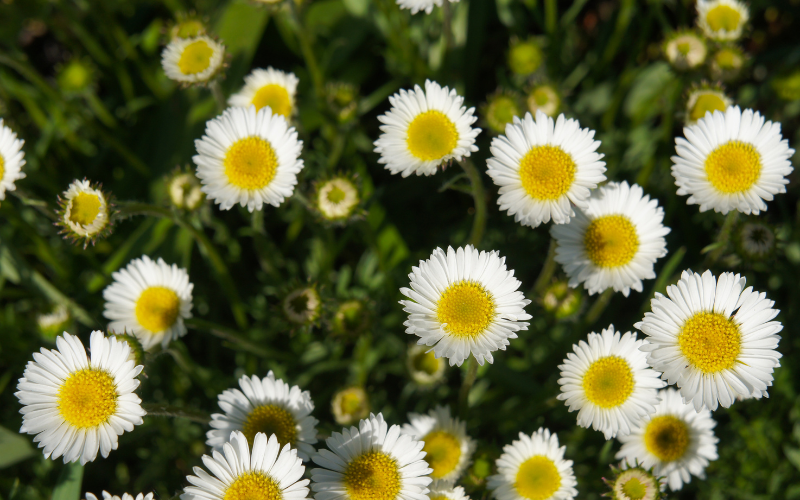
Dwarf Mountain Fleabane is a beautiful flower. It is scientifically known as Erigeron pumilus. It is native to mountainous regions of North America. They typically measure around 1/2 to 3/4 inch (1.3 to 1.9 centimeters) in diameter.
The petals of Dwarf Mountain Fleabane flowers can range in color from white to pale lavender or pink. The central disk is usually yellow or golden in color. The Dwarf Mountain Fleabane is also attracting bees, butterflies, and other beneficial insects to its nectar-rich blooms.
| Scientific Name | Erigeron compositus |
| Native Range | Far eastern Russia, Alaska, Greenland, most of Canada, and the Western United States |
| Flowering Season | Mid to late spring |
Dwarf Iris

Dwarf Iris is a beautiful flower. They typically range in size from around 2 to 4 inches (5 to 10 centimeters) in diameter. Dwarf Iris flowers come in a wide range of colors, including shades of purple, blue, yellow, white, and bi-colored varieties.
Dwarf Iris flowers typically bloom in the spring, although the exact flowering period can vary depending on the specific species or cultivar. These resilient flowers are low-maintenance. The sweet fragrance emitted by these flowers is attracting bees and butterflies to the garden.
| Scientific Name | Iris pumila |
| Native Range | Eastern Europe and Western Asia |
| Flowering Season | Spring and summer |
Dutchman’s Pipe
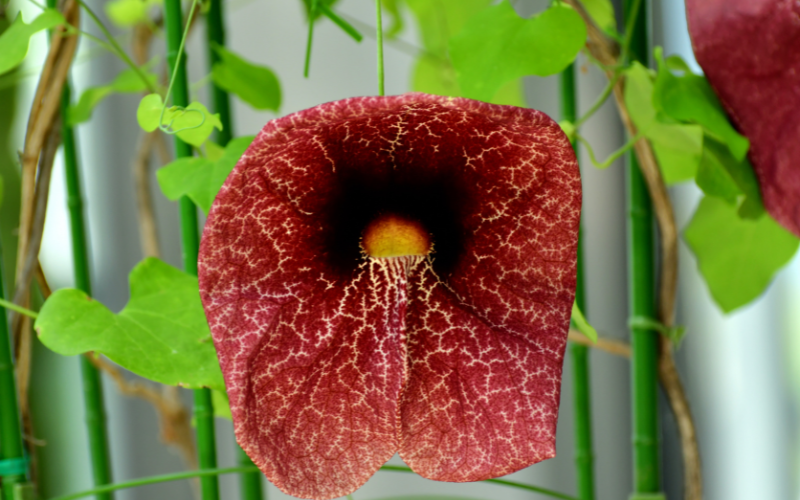
Dutchman’s Pipe is a beautiful flower. The Dutchman’s Pipe Flower, scientifically known as Aristolochia macrophylla. It is native to the eastern regions of North America. The flowers of the Dutchman’s Pipe Flower are relatively large and can measure up to 3 inches (7.6 centimeters) in length.
The Dutchman’s Pipe Flower blooms in late spring to early summer. The Dutchman’s Pipe Flower has large, heart-shaped leaves that are dark green in color. the Dutchman’s Pipe Flower is a fascinating and rewarding addition to any outdoor space.
| Scientific Name | Aristolochia littoralis |
| Native Range | South America |
| Flowering Season | All year (summer and fall in cooler climates) |
Dutchman’s Breeches
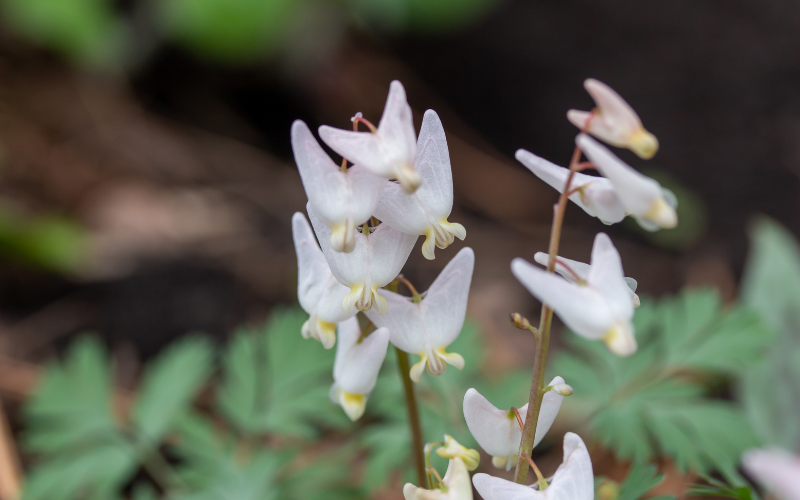
Dutchman’s Breeches is a most beautiful flower. It is scientifically known as Dicentra cucullaria. It is native to eastern North America. Each flower consists of four petals and measures about 1/2 to 3/4 inch (1.3 to 1.9 centimeters) in length.
Dutchman’s Breeches flowers typically bloom in early to mid-spring. Dutchman’s Breeches flowers are typically white or cream in color. The inner part of the flower, including the lobes, may have a yellow or pale yellow tint. The Dutchman’s Breeches flower is known for its whimsical and charming appearance.
| Scientific Name | Dicentra cucullaria |
| Native Range | Pacific Northwest, Atlantic Coast of the United States and Canada, and the central United States |
| Flowering Season | Spring |
Dusty Miller

Dusty Miller is a beautiful flower. It is scientifically known as Jacobaea maritima (formerly Senecio cineraria). The flowers of Dusty Miller are relatively small and not the main feature of the plant. They typically measure less than half an inch (1 centimeter) in diameter.
The flowers of Dusty Miller are typically yellow or yellowish-green in color. Dusty Miller typically blooms in late spring or early summer. The foliage is soft to the touch and has a velvety texture. It is low-maintenance plants that thrive in well-drained soil and full sun to partial shade conditions.
| Scientific Name | Senecio cineraria (aka Jacobaea maritima) |
| Native Range | The Mediterranean region |
| Flowering Season | Spring through summer |
Dragon’s Head
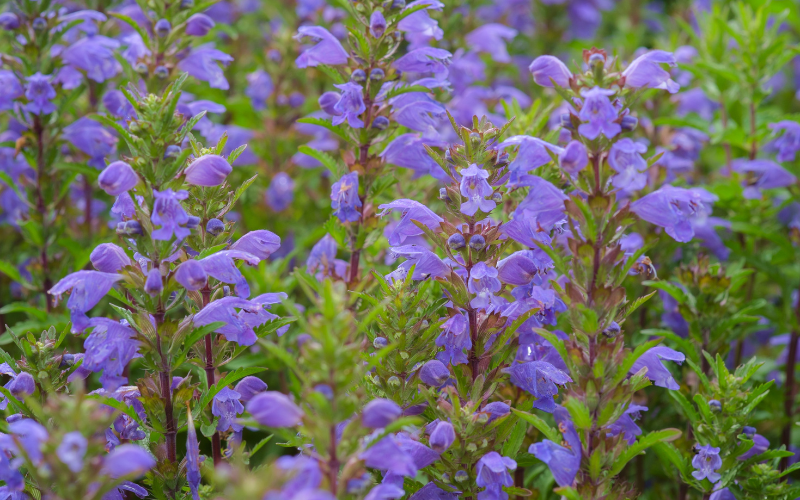
Dragon’s Head is a beautiful flower. It is scientifically known as Dracocephalum and is a genus of flowering plants in the mint family (Lamiaceae). Dragon’s Head flowers come in a range of colors, including shades of blue, purple, pink, and white.
Dragon’s Head flowers typically bloom in late spring to summer, depending on the species and growing conditions. The flowering period can last for several weeks, providing a vibrant display of color. It is a low-maintenance flower.
| Scientific Name | Dracocephalum |
| Native Range | Temperate regions of the Northern Hemisphere |
| Flowering Season | Summer |
Draba
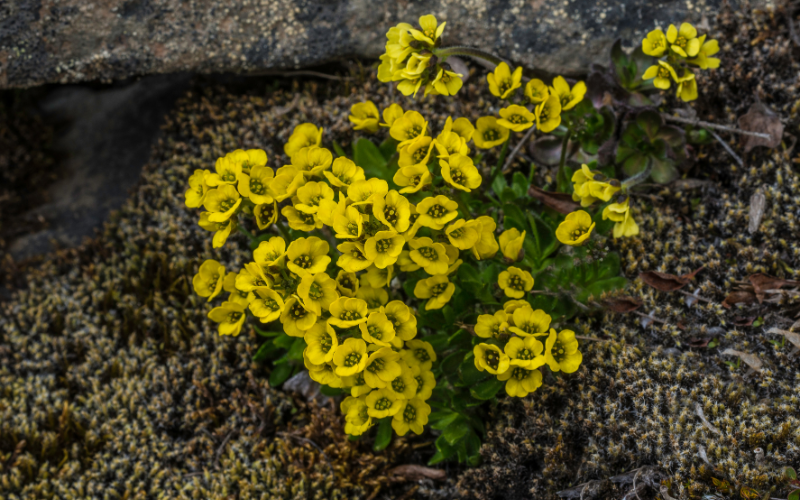
Draba is a beautiful flower. It is also known as Whitlow-grass. The size of Draba flowers can vary depending on the species and cultivar. They typically have small flowers, ranging from about 0.2 to 0.5 inches (0.5 to 1.3 centimeters) in diameter.
Draba flowers come in various colors, including shades of white, yellow, and sometimes pink or purple. The blooming period of Draba flowers varies depending on the species and growing conditions. It is a low-maintenance flower
| Scientific Name | Draba |
| Native Range | Most of the Northern Hemisphere and select Southern Hemisphere locations in South America and Africa |
| Flowering Season | Spring |
Dahlia

Dahlias are beautiful flowers known for their brilliant and varied colors. Native to Mexico and Central America. It is a member of the Asteraceae family. These come in various hues, including red, pink, purple, yellow, and white.
These flowers bloom from mid-summer to early autumn and need well-drained, organic-rich soil. They can grow up to 5 ft. tall. Dahlias are a visual treat for the eyes, with their delicate petal shapes and vibrant colors, giving joy and pleasure anywhere they are found.
| Scientific Name | Dahlia |
| Native Range | Mexico, Central America, and Columbia |
| Flowering Season | Midsummer through fall |
Dogwood
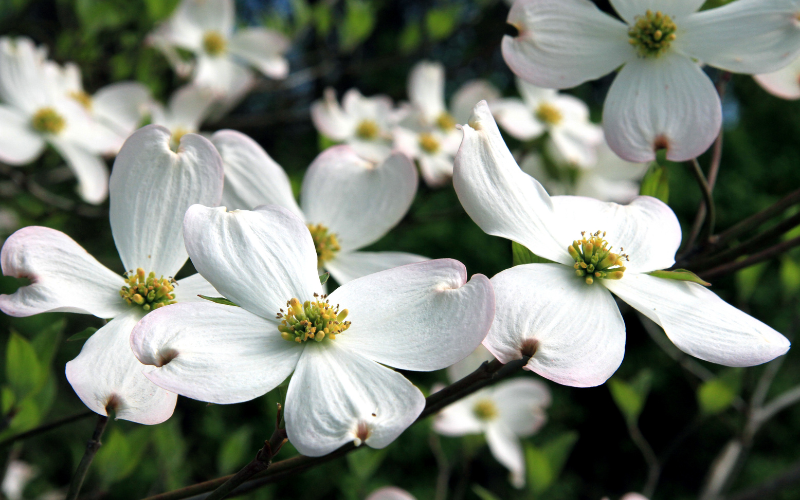
Dogwood, or Cornus, is a common flower in the Cornaceae family. Native to North America, Asia, and Europe, its primary colors are white, pink, and red. They vary in size from small shrubs to medium-sized trees, reaching heights of 40 ft.
Dogwoods bloom in early spring and thrive in well-drained soils. It has been used to cure issues such as fever, pain, and malaria for its antipyretic and anti-inflammatory traits. Dogwoods are a visually attractive and popular asset to any landscape due to their unique look and multi-seasonal charm.
| Scientific Name | Cornus |
| Native Range | Most of the Northern Hemisphere and key locations in the Southern Hemisphere |
| Flowering Season | Spring to early summer |
Digitalis
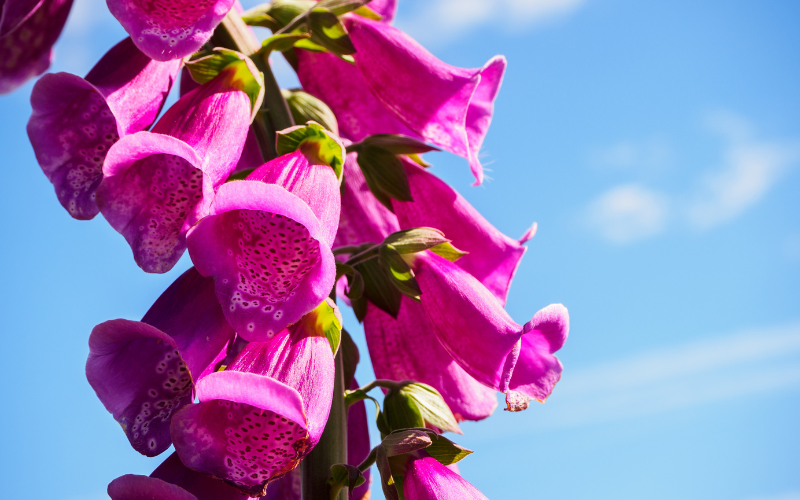
Digitalis, or foxglove, is a member of the Plantaginaceae family. Native to Europe, it comes in a variety of hues, including pink, purple, white, and yellow. Blooms in late spring to early summer, prefer well-drained soil and grow well in partial shade.
Digitalis can grow to be 3 to 6 feet tall and their leaves contain high cardiac glycosides which have been used in traditional medicine to treat cardiac issues. The unique look of Digitalis, with its tall spikes covered with lovely, tubular blooms, makes it a charming addition to any garden.
| Scientific Name | Digitalis |
| Native Range | Europe, northwestern Asia, Algeria, Morocco, Turkey, and the Mediterranean region |
| Flowering Season | Early summer |
Dutch Iris
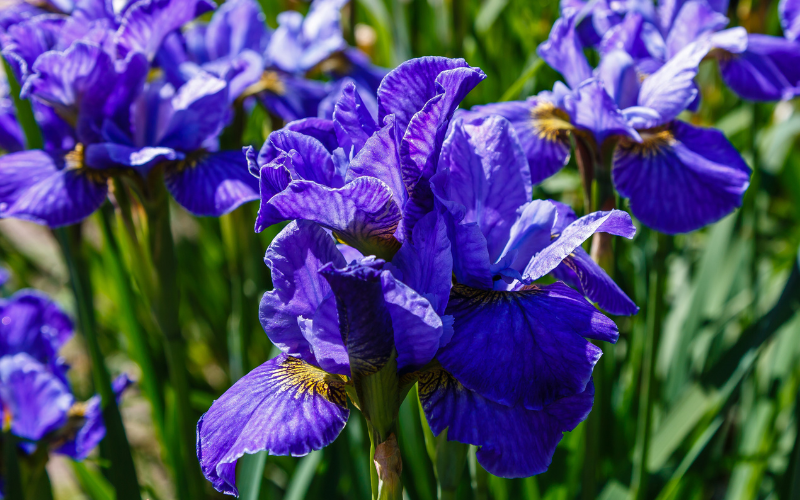
The Dutch Iris, scientifically known as Iris x hollandica, is an elegant plant in the Iridaceae family. It is native to Spain, Portugal, and North Africa and has an amazing array of purple, blue, yellow, and white hues.
These blooms grow to about 20-30 inches in height and thrive in well-drained soil, growing in late spring or early summer. Its unique, gorgeous blooms and sword-like foliage give a touch of elegance and charm to any landscape, showing its beauty and versatility.
| Scientific Name | Iris x hollandica |
| Native Range | Artificial hybrid |
| Flowering Season | Late spring to early summer |
Desert Dandelion
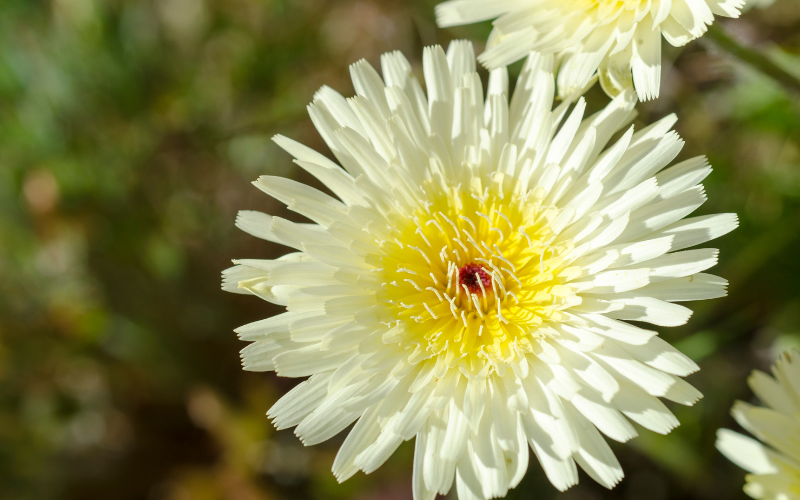
Desert Dandelion, or Malacothrix glabrata, is a unique member of the Asteraceae family, native to dry parts of North America, mainly the southwestern United States and northern Mexico. This flower blooms in early spring and vary in color from pale yellow to vivid golden colors.
It thrives on well-drained soils and can reach up to 1-2 ft. tall. The Desert Dandelion has smooth, angled leaves that give it a unique look. Its flower heads are made up of many tiny ray petals that extend from a central disc, making a lovely flower while offering nectar to insects in the dry desert, like bees and butterflies.
| Scientific Name | Malacothrix glabrata |
| Native Range | The deserts of the western and southwestern United States and northwestern Mexico |
| Flowering Season | Late winter to early summer |
Devil’s Claw
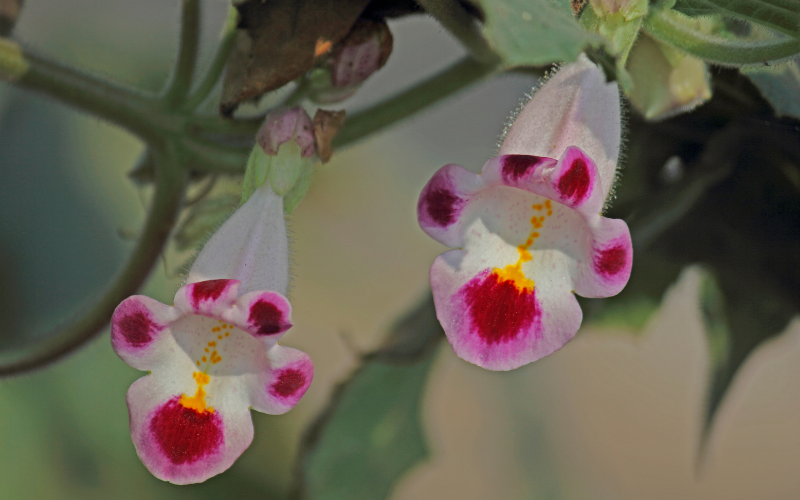
Devil’s Claw, or Proboscidea louisianica, is an incredible plant of the Martyniaceae family. Native to the desert parts of Southern Africa, has long, root structures and low-growing, spreading stems coated with sharp, claw-like claws. It has flowers in colors, including yellow, orange, and red.
Devil’s Claw grows well in well-drained soil and blooms in late summer and early autumn. This flower may grow to a height of up to 5 ft. and has anti-inflammatory & soothing effects, making it helpful for curing arthritis and joint pain. Devil’s Claw is an exciting flower that continues to amaze nature lovers.
| Scientific Name | Harpagophytum |
| Native Range | Southern Africa |
| Flowering Season | Late spring to early summer |
Dancing Lady Orchid
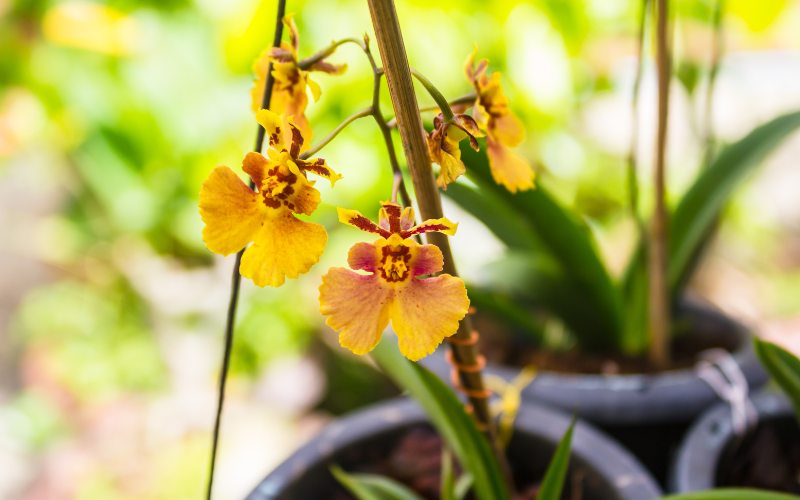
The Dancing Lady Orchid, or Oncidium, is a lovely flower from the Orchidaceae family. Native to Central and South America’s tropical regions, they appear in an array of hues, including yellow, pink, orange, and red, with complex designs or dots.
These orchids demand well-draining, fairly fertile soil and often bloom in late spring or summer. These can grow to be 3 ft. tall. The Dancing Lady Orchid is surely a sight delight with its graceful arching stems, delicate petals, and unique lips, and adds grace and beauty to any garden.
| Scientific Name | Oncidium |
| Native Range | Florida, Mexico, Central America, parts of the Caribbean, and South America |
| Flowering Season | Once or twice per year, during any season |
Desert Willow
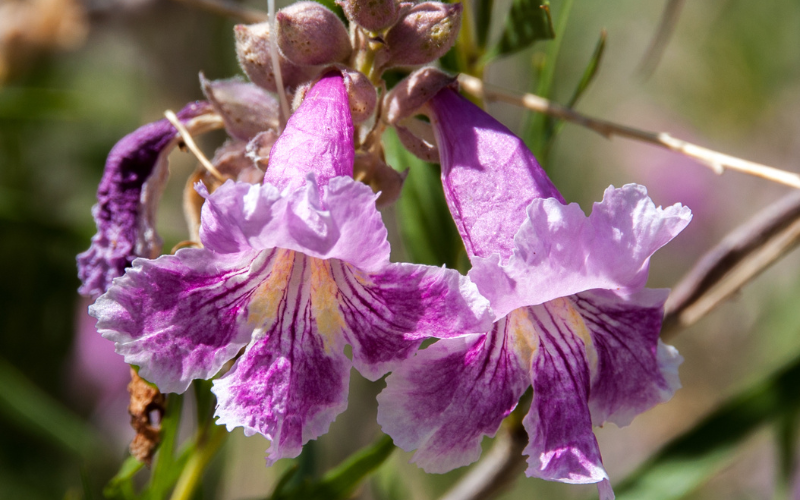
The Desert Willow, or Chilopsis linearis, is an amazing flower of the Bignoniaceae family. Native to the southwestern United States and parts of Mexico, this produces amazing trumpet-shaped blooms in pink, lavender, and white and can grow up to 35 feet tall. These bloom from spring to early autumn, and favor sandy, well-drained soils.
Desert Willow has been used to cure fevers, headaches, and stomach issues. Its soft foliage and gracefully weeping branches give it an attractive and unique look, making it an ideal flower for a desert and showing the beauty and adaptation of desert environments.
| Scientific Name | Chilopsis linearis |
| Native Range | Southwestern and south-central United States and Northern Mexico |
| Flowering Season | Spring |
Douglas Iris
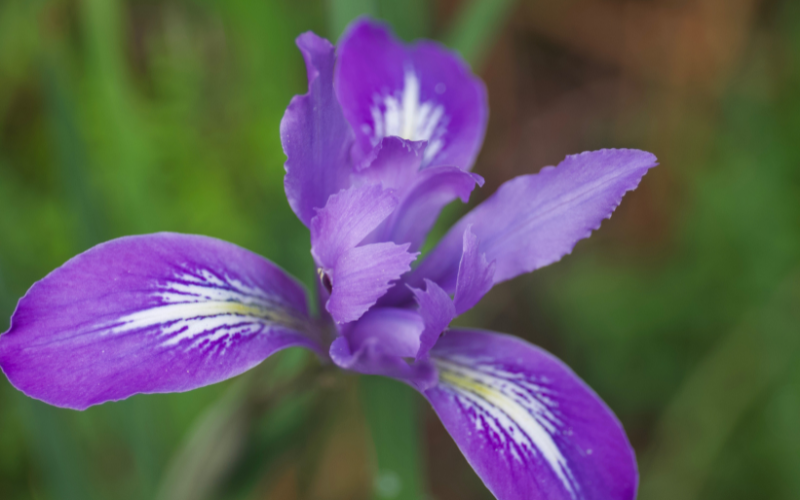
The Douglas Iris, or Iris douglasiana, is a beautiful bloom in the Iridaceae family. It is native to the coastal regions of California and Oregon and comes in rich purple, lavender, blue, and even yellow. This flower blooms in the spring and grows to be 2 ft. tall in well-drained soil.
The iris has been associated with symbolic meaning in several cultures, often representing beauty, hope, and wisdom. It has an appealing look, inviting both human lovers and pollinators with its charming and alluring aura.
| Scientific Name | Iris douglasiana |
| Native Range | Coastal Oregon and California |
| Flowering Season | Spring |
Dayflower
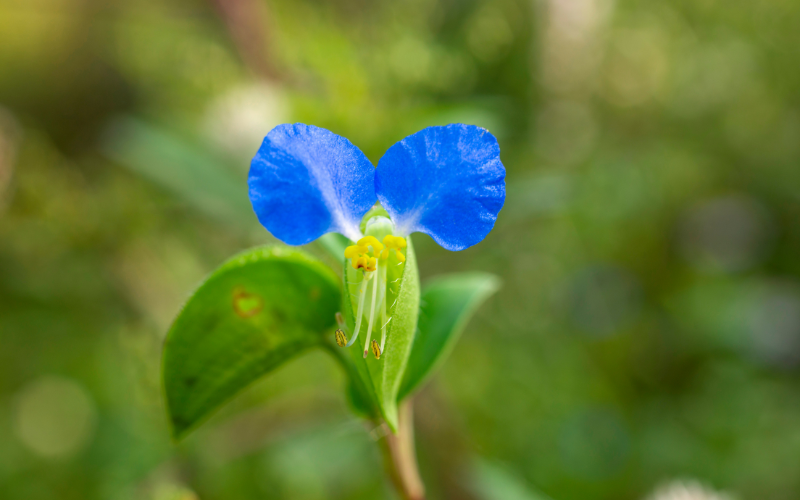
The Dayflower, or Commelina, is an appealing plant in the Commelinaceae family. Native to tropical and subtropical places worldwide, the Dayflower appears in a range of colors, including blue, purple, and white.
Dayflower blooms in the summer and early fall prefers moist, well-drained soil, and can grow up to 2 ft. tall. They are anti-inflammatory and diuretic in nature. Dayflowers give a touch of luxury and charm to any garden with their typical thin leaves and gentle blooms.
| Scientific Name | Commelina |
| Native Range | Asia, Americas |
| Flowering Season | Spring or fall |
Dwarf Sunflower
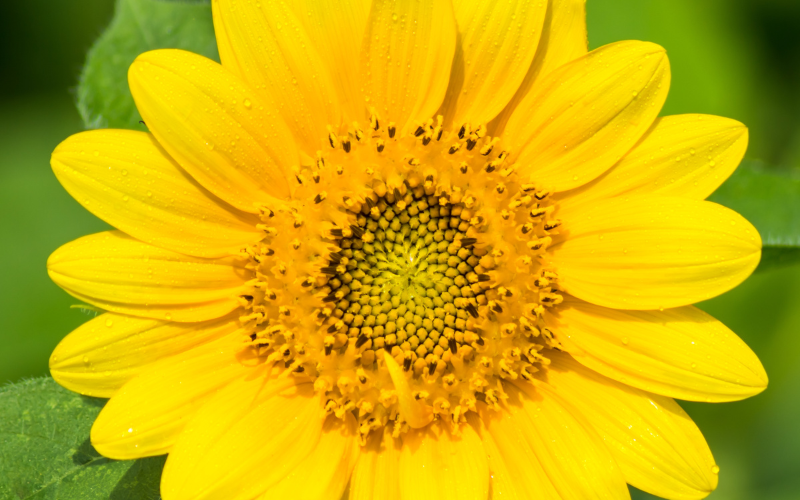
The dwarf sunflower is a captivating and charming flower. It is also known as Helianthella parryi. It is native to North America. They come in various vibrant colors yellow and shades of orange.
Dwarf sunflowers typically bloom from late spring to early fall. Dwarf sunflowers are easy to grow and can thrive in well-drained soil.
| Scientific Name | Helianthella parryi |
| Native Range | North American |
| Flowering Season | Late spring to early fall |
Dutchman’s Pipe Flower
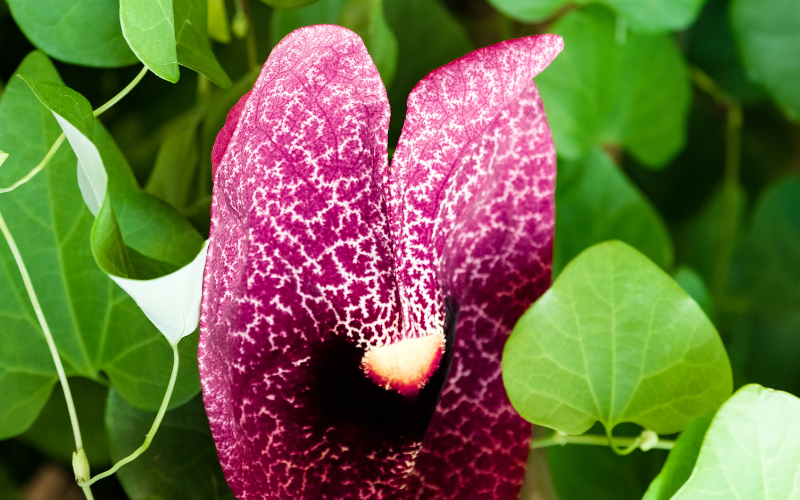
Dutchman’s Pipe is a unique flower. It is scientifically known as Aristolochia. It is native to North and South America, Asia, and Europe. They typically have muted colors, such as brown, maroon, or green.
Dutchman’s Pipe flowers typically bloom from late spring through the summer months. It prefers well-drained soil and thrives in partial to full shade.
| Scientific Name | Aristolochia |
| Native Range | Southeastern Canada and the Eastern United States |
| Flowering Season | Spring – Summer |
Drumstick Flower

The drumstick is a fascinating flower. It is also known as the Moringa flower. It is native to the Indian subcontinent. They are typically white, pale yellow, or cream in color.
It thrives in warm and arid climates and is often found in tropical and subtropical regions. They require full sun for optimal growth.
| Scientific Name | Moringa oleifera |
| Native Range | Africa, Asia |
| Flowering Season | Late Spring Through the Summer |
Douglas Aster

The Douglas Aster is a stunning flower. It is scientifically known as Symphyotrichum subspicatum. It is native to North America. The Douglas Aster showcases delicate clusters of lavender-blue flowers with a yellow center.
Douglas Aster prefers well-drained soil and can thrive in a variety of soil types. It typically grows in full sun to partial shade.
| Scientific Name | Symphyotrichum Subspicatum |
| Native Range | North America |
| Flowering Season | Late Summer to Early Fall |
Double Impatiens
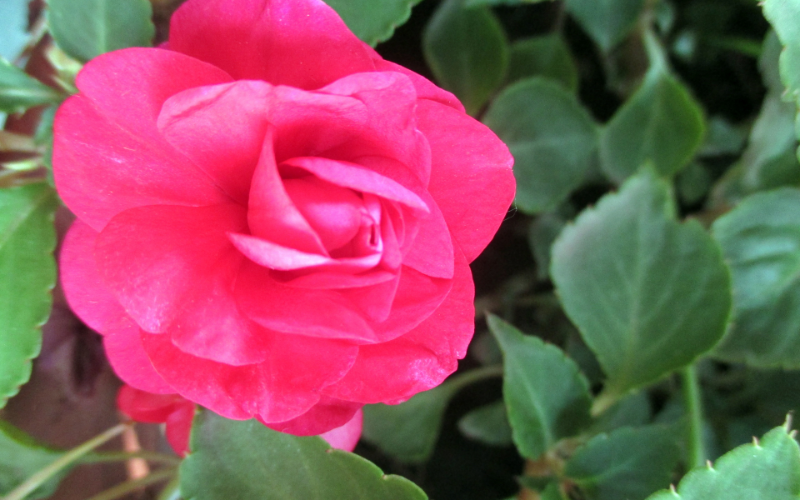
Double Impatiens is a beautiful flower. It is scientifically known as Impatiens Walleriana. They come in a wide range of vibrant colors, including shades of red, pink, orange, purple, white, and more.
The flowers are typically small, measuring about 1 to 2 inches in diameter. It is commonly planted in pots, hanging baskets, and garden beds.
| Scientific Name | Impatiens hawkeri |
| Native Range | Central America |
| Flowering Season | Late Spring or Early Summer |
Dogtooth Violet
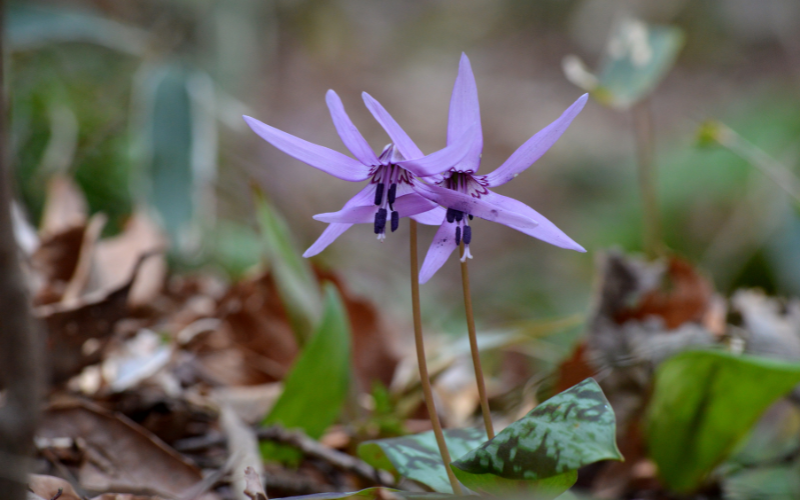
The Dogtooth Violet is a charming flower. It is also known as Erythronium dens-canis. It is native to Europe and Asia. The Dogtooth Violet can range in color from pale pink to lavender or rosy purple.
The flowers are relatively small, typically around 1 to 1.5 inches (2.5 to 4 cm) in diameter. The Dogtooth Violet prefers partially shaded to bright sunlight, making it well-suited for woodland gardens.
| Scientific Name | Erythronium dens-canis |
| Native Range | Central and Southern Europe |
| Flowering Season | Spring |
Dogbane
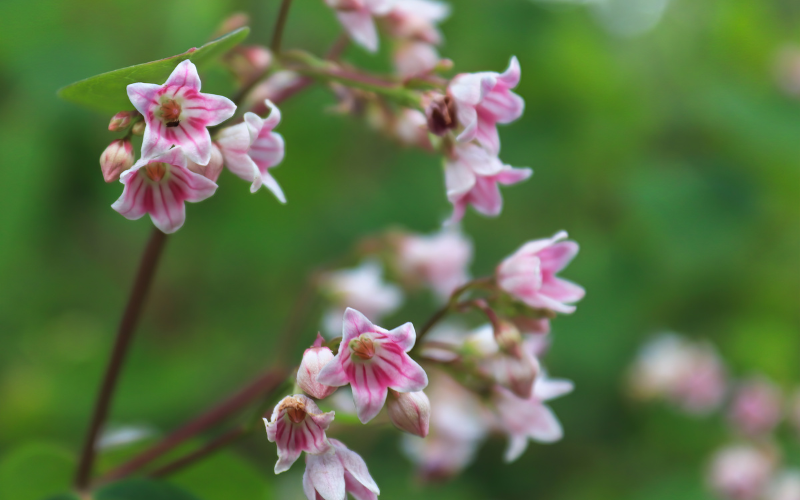
The dogbane flower is a stunning and unique plant. It is also known by its scientific name Apocynum cannabinum. It is native to North America. Dogbane plants produce small, bell-shaped flowers that are typically white or pink.
The flowers have a tubular or bell-like shape, and they typically have five petals. Dogbane flowers typically bloom from late spring through the summer months.
| Scientific Name | Apocynum |
| Native Range | North America |
| Flowering Season | Late Spring Through Summer |
Dill
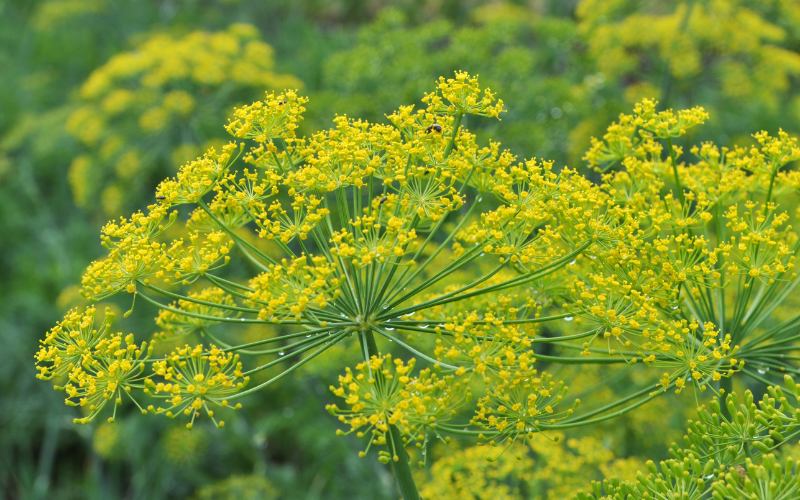
Dill is a unique flower. It is scientifically known as Anethum graveolens. It is native to the Mediterranean region and parts of Asia. Dill flowers typically bloom during the summer months.
Dill is a hardy annual herb that grows well in full sun. It prefers well-drained soil and can tolerate somewhat poor or sandy soils.
| Scientific Name | Anethum graveolens |
| Native Range | Southeastern Europe |
| Flowering Season | Late Summer, Early Fall |
Dog Rose
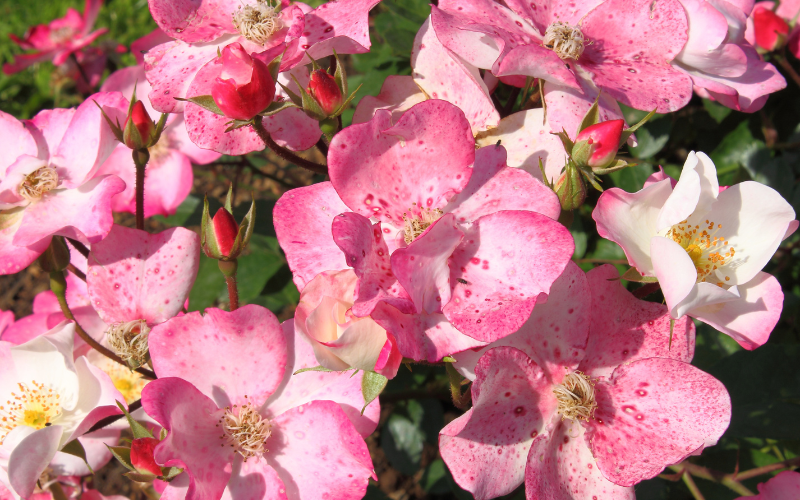
The Dog Rose is a beautiful flower. It is scientifically known as Rosa canina. It is native to Europe, North Africa, and parts of Asia. The flowers come in shades of pink, white, or even a soft yellow.
The flowers are relatively small, usually around 1 to 2 inches (2.5 to 5 cm) in diameter. It is typically blooms in late spring to early summer. It can thrive in a range of soil types, from sandy to loamy.
| Scientific Name | Rosa canina |
| Native Range | Europe, North Africa, and parts of Asia |
| Flowering Season | Late Spring to Early Summer |
Digiplexis
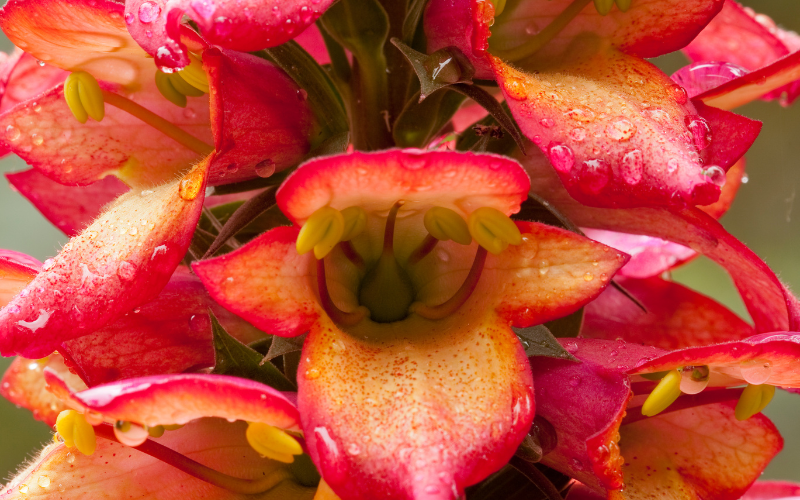
Digiplexis is a lovely flower. It is also known as Digitalis x valinii. The flowers are relatively small, measuring about 1 to 2 inches (2.5 to 5 cm) in length. Digiplexis typically blooms in late spring to early summer.
Digiplexis flowers come in a range of vibrant colors, including shades of pink, orange, and red. Digiplexis thrives in well-drained soil and prefers full sun to partial shade.
| Scientific Name | Digitalis Purpurea |
| Native Range | Europe, Western Asia, and Northwestern Africa |
| Flowering Season | Late Spring to Early Summer |
Question & Answer
Which is the world’s largest lotus flower?
The world’s largest lotus flower is the Giant Lotus (Nelumbo nucifera ‘Giant’) variety.
What is the queen of flowers in the world?
The rose is often referred to as the “queen of flowers.”
What is the smallest flower in India?
The smallest flower in India is believed to be the Wolffia globosa, commonly known as Asian watermeal or minute duckweed.
Which flower lasts long in water?
Chrysanthemums have a long vase life and can last up to two weeks or more in water.
